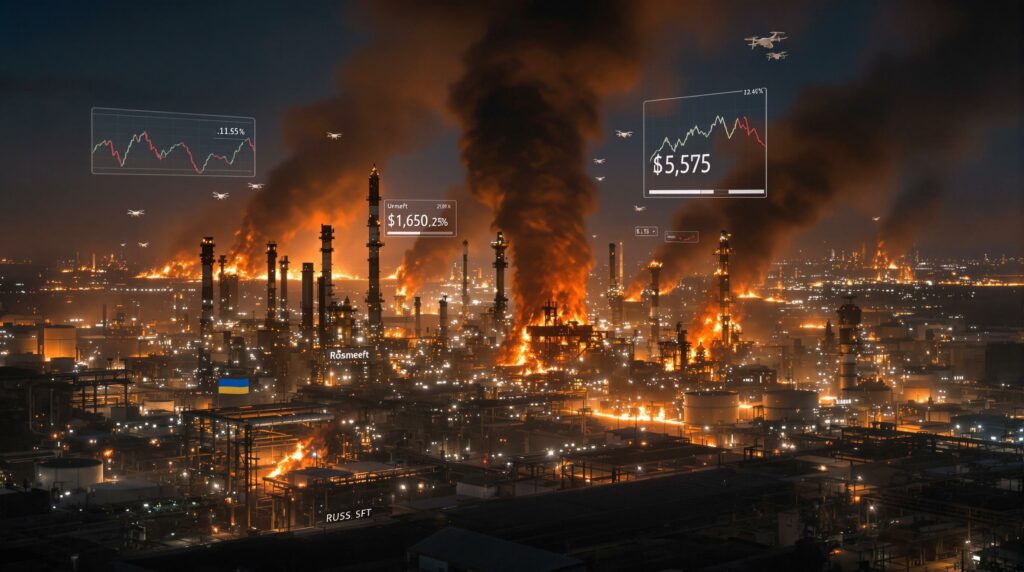What Happened in the Recent Drone Attack on Rosneft?
The landscape of modern warfare continues to evolve as drones increasingly target vital infrastructure. Recently, a precision Ukrainian drone strike hit a major Rosneft oil refinery, forcing immediate operational shutdown and creating significant ripple effects throughout Russia's energy sector. According to breaking news reports from August 2023, the attack targeted a facility with strategic importance to Russia's domestic fuel supply chain.
The strike caused substantial damage to critical refining equipment, necessitating emergency shutdown procedures to prevent catastrophic secondary explosions and fires. Technical assessment teams immediately deployed to evaluate structural damage and determine the repair timeline, while emergency response units worked to contain any potential environmental impact from the incident.
Attack Details and Immediate Consequences
The drone strike demonstrated remarkable precision, bypassing perimeter defenses to target specific high-value components within the refinery complex. Initial reports indicated the attack focused on distillation units and control systems—components known to be particularly vulnerable and whose damage could maximize operational disruption with minimal explosive payload.
The timing of the strike appeared strategically calculated, occurring during a period of peak operational activity when the facility was processing near maximum capacity. This timing magnified the immediate production impact and complicated emergency response efforts as more personnel were on-site during the incident.
Facility Specifics and Production Impact
The targeted Rosneft refinery represents a significant node in Russia's domestic energy infrastructure network, with processing capacity estimated between 300,000-400,000 barrels per day. This facility primarily produced diesel fuel, gasoline, and aviation fuel for both civilian and military applications, making it a strategically valuable target.
The shutdown immediately created production gaps in Russia's refined petroleum products supply chain. Most significantly affected were:
- Ultra-low sulfur diesel production (approximately 140,000 barrels per day)
- Aviation fuel (approximately 85,000 barrels per day)
- Premium gasoline grades (approximately 110,000 barrels per day)
Market analysts estimate the facility could remain offline for 3-8 weeks depending on the availability of replacement components and the extent of damage to precision control systems, which often require specialized manufacturing with extended lead times.
How Are Drone Strikes Changing the Energy Security Landscape?
The proliferation of drone technology has fundamentally altered traditional concepts of energy security. What once required sophisticated military aircraft and substantial resources can now be accomplished with commercially available technology modified for military purposes. This democratization of precision strike capability represents a paradigm shift in infrastructure vulnerability assessment.
Energy security experts have noted that fixed infrastructure protection doctrines developed during the Cold War era have proven woefully inadequate against these new threats. The attack on Rosneft's facility demonstrates how relatively inexpensive unmanned aerial vehicles can effectively neutralize billions of dollars in energy infrastructure with minimal risk to the attacking force.
Vulnerability of Fixed Energy Assets
Oil refineries present particularly attractive targets due to several inherent characteristics:
- Large physical footprints spanning hundreds of acres
- Inherently hazardous processing involving flammable materials under pressure
- Critical control systems often concentrated in specific locations
- Complex interdependent processing units where damage to one component can halt entire production chains
- Limited redundancy in specialized processing equipment
- High visibility with thermal signatures easily detected from aerial platforms
Traditional air defense systems struggle to counter modern drone threats due to their design optimization for larger, faster-moving conventional aircraft. Small commercial drones modified for attack purposes often fly low, slow, and follow unpredictable patterns—characteristics that confound conventional radar and air defense networks designed for military aircraft.
Economic and Strategic Implications
Beyond immediate physical damage, drone strikes against energy infrastructure create cascading economic effects:
- Direct repair costs: Estimated between $10-50 million depending on component damage
- Lost production revenue: Approximately $15-30 million daily depending on current oil price movements
- Market confidence impacts: Increased risk premiums on Russian energy exports
- Insurance cost escalation: Premium increases of 30-200% for facilities in vulnerable regions
- Defense expenditure requirements: Billions in additional protection systems across the energy sector
Perhaps most significantly, these attacks demonstrate a strategic vulnerability in Russia's national energy infrastructure. With more than 40% of Russia's federal budget revenue derived from oil and gas operations, the ability to disrupt these cash flows represents a powerful economic lever in the ongoing conflict.
What Does This Mean for Global Oil Markets?
Global oil markets have responded to the Rosneft refinery attack with measured concern rather than panic. Crude oil futures showed initial price increases of 0.5-1% as traders assessed potential supply disruptions, but these gains moderated as market participants recognized the attack primarily impacts refined products rather than crude production capacity.
The more pronounced market effects are appearing in refined product futures, particularly diesel and jet fuel, where European delivery contracts have seen premiums increase by 3-5% since the attack. This price response reflects the reality that while crude oil remains abundant globally, refining capacity constraints—particularly for specific fuel grades—can create regional supply tightness that's more difficult to address through global trade flows.
Short-Term Price Reactions
Market data reveals several noteworthy price reactions following the attack:
- Brent crude futures initially rose $0.85 before settling at a more modest $0.35 gain
- ULSD (Ultra Low Sulfur Diesel) futures showed stronger gains of approximately $0.07-0.09 per gallon
- Refined product crack spreads widened by 5-7%, indicating traders anticipate refining margins to improve due to capacity constraints
- Russian Urals crude discount to Brent widened by approximately $0.40-0.60 per barrel
Energy economists note these price movements reflect rational market behavior rather than panic—a recognition that while significant, this attack represents a manageable disruption in the context of global energy flows.
Refining Capacity and Product Flows
The most pronounced impacts will likely manifest in refined product markets rather than crude oil price rally. With Russian refining capacity temporarily reduced by an estimated 300,000-400,000 barrels per day, regional diesel and gasoline supplies face potential tightening, particularly in markets traditionally supplied by Russian exports.
To compensate for these disruptions, market analysts anticipate several market adjustments:
- Increased utilization rates at unaffected Russian refineries
- Redirection of product flows from Asian markets to European destinations where premiums justify the additional shipping costs
- Higher utilization rates at European refineries to capture improved margins
- Potential releases from strategic product reserves if shortages develop in critical markets
These adaptive mechanisms highlight the global oil market's resilience to localized disruptions, though the system's flexibility does not eliminate price impacts entirely.
How Is Rosneft Responding to the Attack?
Rosneft has implemented a comprehensive response strategy focusing on immediate damage containment, worker safety, and business continuity. The company activated emergency response protocols within minutes of the attack, demonstrating well-rehearsed crisis management capabilities developed through years of operational risk planning.
Company leadership has established a dedicated crisis management team reporting directly to the CEO, with specialized workstreams addressing technical repair requirements, supply chain adjustments, customer communication, and enhanced security measures across all company facilities.
Emergency Response and Security Measures
Rosneft's immediate response prioritized several critical objectives:
- Ensuring personnel safety through facility evacuation and accountability procedures
- Implementing fire suppression systems to prevent damage escalation
- Isolating damaged processing units to protect interconnected systems
- Establishing security perimeters to prevent secondary attacks
- Activating mutual aid agreements with regional emergency services
The company has substantially enhanced security measures across its network of refining assets following the attack. These measures reportedly include:
- Deployment of advanced radar systems capable of detecting small unmanned aerial vehicles
- Installation of radio frequency jammers to disrupt drone control signals
- Establishment of restricted airspace zones enforced by rapid response air defense units
- Implementation of physical barriers and nets to protect particularly vulnerable processing equipment
- Expanded security perimeters with enhanced surveillance capabilities
These defensive measures represent a significant capital investment, estimated at $75-100 million per major facility, with ongoing operational costs of approximately $10-15 million annually.
Business Continuity Plans
To maintain supply chain integrity during the repair period, Rosneft has activated several contingency measures:
- Production reallocation: Increasing production at unaffected refineries by an estimated 5-8% through deferred maintenance and enhanced utilization rates
- Import arrangements: Securing refined product imports from friendly nations to fulfill contractual obligations
- Storage utilization: Strategic deployment of approximately 28 million barrels of product stored throughout the company's logistics network
- Customer prioritization: Implementing allocation procedures prioritizing critical infrastructure, military requirements, and long-term contract customers
These measures demonstrate Rosneft's operational resilience while highlighting the challenges even well-prepared organizations face when confronting asymmetric threats to fixed infrastructure.
What Is the Broader Context of Energy Infrastructure Targeting?
The targeting of energy infrastructure represents a longstanding strategy in modern conflicts, with historical precedents stretching back to World War II and beyond. What distinguishes current attacks is the democratization of precision strike capability through relatively inexpensive drone technology and advanced targeting systems available to non-state actors and smaller military forces.
This evolution represents a fundamental shift in the risk calculus surrounding critical infrastructure protection. Assets once considered secure due to distance from conventional battlefields now exist within the operational reach of adversaries equipped with modern drone technology and willing to employ it against civilian infrastructure.
Historical Precedents and Patterns
Energy infrastructure targeting has evolved through several distinct phases:
- World War II (1939-1945): Strategic bombing campaigns against oil refineries, synthetic fuel plants, and transportation networks required hundreds of aircraft and thousands of personnel
- Gulf War (1991): Precision strikes against Iraqi energy infrastructure utilized expensive cruise missiles and stealth aircraft
- Iraq War (2003): Similar targeting required sophisticated air defense suppression and extensive intelligence preparation
- Yemen Conflict (2019): Houthi drone strikes against Saudi Aramco facilities demonstrated how non-state actors could target energy infrastructure with low-cost systems
- Russia-Ukraine Conflict (2022-present): Widespread, systematic targeting of energy infrastructure using consumer-grade drones modified for military purposes
This progression demonstrates the decreasing resource threshold required to execute effective strikes against energy infrastructure. What once required a major air force can now be accomplished by small teams with commercially derived technology.
International Legal and Security Frameworks
The targeting of civilian energy infrastructure occupies a contested space within international humanitarian law. The Geneva Conventions and their Additional Protocols generally prohibit attacks against installations containing dangerous forces if such attacks might cause severe civilian losses. However, energy infrastructure supporting military operations exists in a legal gray area where military necessity arguments can be advanced by attacking forces.
International security organizations have struggled to develop effective countermeasures against this evolving threat. Traditional approaches focused on deterrence through retaliatory capability have proven less effective against adversaries willing to accept asymmetric risk calculations or attribution ambiguity.
Several frameworks have emerged to address these challenges:
- Critical Infrastructure Protection protocols developed by NATO
- United Nations Security Council resolutions addressing energy security challenges
- Bilateral security cooperation agreements focusing on infrastructure resilience
- Industry-led initiatives like the Oil and Gas Information Sharing and Analysis Center (ONG-ISAC)
Despite these efforts, the protection gap remains substantial as defensive technologies struggle to keep pace with the rapid evolution of offensive capabilities.
How Might This Impact Russia's Energy Export Strategy?
The drone strike on Rosneft's refinery forces a strategic reconsideration of Russia's energy infrastructure vulnerability and export strategy. Russian energy companies face difficult decisions balancing infrastructure hardening investments against distributed production models that might sacrifice efficiency for enhanced resilience.
Energy security experts note that Russia's traditional approach of centralized, large-scale production facilities creates inherent vulnerabilities that may no longer be acceptable given demonstrated drone strike capabilities. This could accelerate a shift toward smaller, more distributed processing facilities despite their higher per-barrel operating costs.
Adaptation and Resilience Building
Russian energy companies, including Rosneft, are likely to pursue several adaptation strategies:
- Infrastructure hardening: Implementing physical protection measures, enhanced air defense systems, and redundant control capabilities
- Distributed processing: Developing smaller, geographically dispersed refining capabilities to reduce single-point vulnerability
- Underground facilities: Exploring subterranean processing options for particularly critical components
- Redundant capacity: Maintaining excess processing capability to ensure continued operations despite periodic attacks
- Digital twins: Implementing comprehensive digital simulation capabilities to speed recovery from physical damage
These measures represent substantial capital investment requirements, potentially reaching $15-20 billion across Russia's refining sector over the next 3-5 years. This investment necessity creates additional financial pressure at a time when sanctions already constrain capital access.
Export Reliability Concerns
For international buyers of Russian energy products, these incidents raise legitimate questions about supply reliability. Countries heavily dependent on Russian refined products may implement several risk mitigation strategies:
- Diversifying supply sources despite potentially higher costs
- Increasing strategic reserves beyond mandated levels
- Developing contingency import arrangements with alternative suppliers
- Investing in domestic refining capacity to reduce import dependence
- Negotiating force majeure clauses with specific provisions for conflict-related disruptions
These adjustments could gradually reshape regional energy trade patterns, potentially accelerating the eastward shift of Russian energy exports toward markets less concerned about reliability issues or better positioned to implement mitigation measures.
What Are the Insurance and Risk Management Implications?
The insurance market for energy infrastructure in conflict-adjacent regions has experienced substantial disruption following repeated drone strikes. Underwriters have fundamentally reassessed risk models that previously considered physical attacks on infrastructure outside active combat zones as low-probability events.
This reassessment has created challenging conditions for energy companies operating in vulnerable regions, with premium increases, coverage limitations, and in some cases, complete withdrawal of insurance capacity for certain types of risks or specific geographical areas.
Rising Premiums and Coverage Challenges
Insurance market data reveals several concerning trends:
- Property damage premiums for refineries in vulnerable regions have increased 150-400% since 2022
- Deductibles have risen from typical levels of $5-10 million to $50-100 million for similar facilities
- Some insurers have introduced explicit exclusions for drone-related damage
- War risk endorsements previously applied primarily to marine assets now extend to fixed infrastructure
- Business interruption coverage limits have been substantially reduced, often by 50% or more
These changes significantly impact the total cost of ownership for refining assets in vulnerable regions, adding $0.20-0.35 per barrel in effective operating costs according to industry analysts. This cost disadvantage further compounds the challenges faced by Russian energy companies operating under sanctions regimes with limited access to international insurance markets.
Risk Mitigation Strategies
Energy companies are implementing sophisticated risk management approaches to address these challenges:
- Captive insurance programs: Self-insurance mechanisms funded directly by energy companies to reduce dependence on commercial insurance markets
- Parametric insurance products: Index-based policies that pay predetermined amounts based on triggering events rather than assessed damage
- Risk retention: Accepting higher deductibles and self-insured retentions to reduce premium costs
- Operational adjustments: Maintaining lower throughput levels to reduce maximum foreseeable loss scenarios
- Physical modifications: Implementing blast walls, containment systems, and other physical protections to reduce damage potential
"The risk landscape for fixed energy infrastructure has fundamentally changed," notes a senior insurance executive at a major London market insurer. "What we're seeing is a structural shift in how these assets must be protected, insured, and operated in regions vulnerable to drone strikes."
These adaptive strategies highlight how financial markets are driving operational changes in response to evolving security threats, creating powerful economic incentives for enhanced physical security measures.
FAQs About Drone Strikes on Oil Infrastructure
How vulnerable are oil refineries to drone attacks?
Oil refineries present particularly attractive targets due to their inherent characteristics. These facilities typically occupy large physical footprints—often exceeding 1,000 acres for major refineries—with numerous vulnerable components exposed to aerial attack. Critical refinery components like distillation columns, catalytic crackers, and control systems represent high-value targets where relatively small explosive payloads (5-10 kg) can cause disproportionate damage.
The process nature of refining operations creates additional vulnerabilities, as damage to specific nodes can force the shutdown of entire production chains. For example, a modern refinery typically processes crude oil through 15-20 interconnected units, where the failure of any single component can halt downstream processes. This interdependence magnifies the impact of precision strikes against key components.
Refineries also process inherently flammable materials under high temperature and pressure conditions, creating secondary damage potential beyond the initial explosive impact. A strike against a hydrocracker operating at 3,000 psi could trigger catastrophic releases that significantly amplify the attack's effectiveness.
Can these facilities be effectively protected against drones?
Protecting large industrial facilities against small, agile drones presents substantial technical and economic challenges. Traditional air defense systems designed for conventional aircraft lack the detection and engagement capabilities needed for small unmanned aerial vehicles with minimal radar cross-sections, low thermal signatures, and unpredictable flight patterns.
Current protection technologies include:
- Radio frequency jammers: Effective within limited ranges (typically 1-3 km) against commercial drones using standard control frequencies
- Directed energy weapons: Laser-based systems capable of disabling drones but requiring precise tracking and substantial power generation
- Kinetic interceptors: Counter-drone systems using nets, projectiles, or other physical means to disable attacking drones
- Electronic warfare systems: Advanced capabilities that can detect, identify, and disrupt drone control signals
- Physical barriers: Protective netting, walls, and covers for particularly vulnerable equipment
Complete protection remains elusive given the extensive perimeters of most refining facilities (often exceeding 10-15 km) and the relatively low cost of attacking drones compared to defensive
Ready to Get Ahead of the Next Major Discovery?
Discover significant mineral opportunities before the market with Discovery Alert's proprietary Discovery IQ model, delivering real-time notifications on ASX announcements and transforming complex data into actionable insights. Explore how major discoveries can lead to substantial returns by visiting Discovery Alert's dedicated discoveries page.




